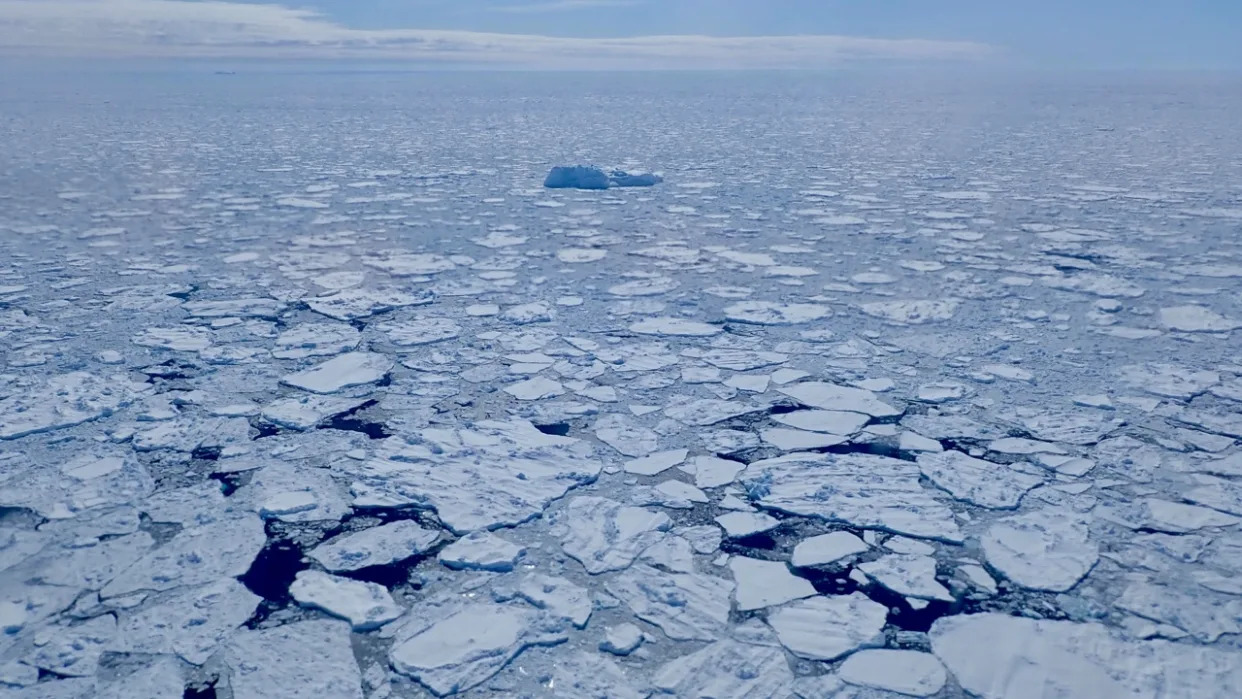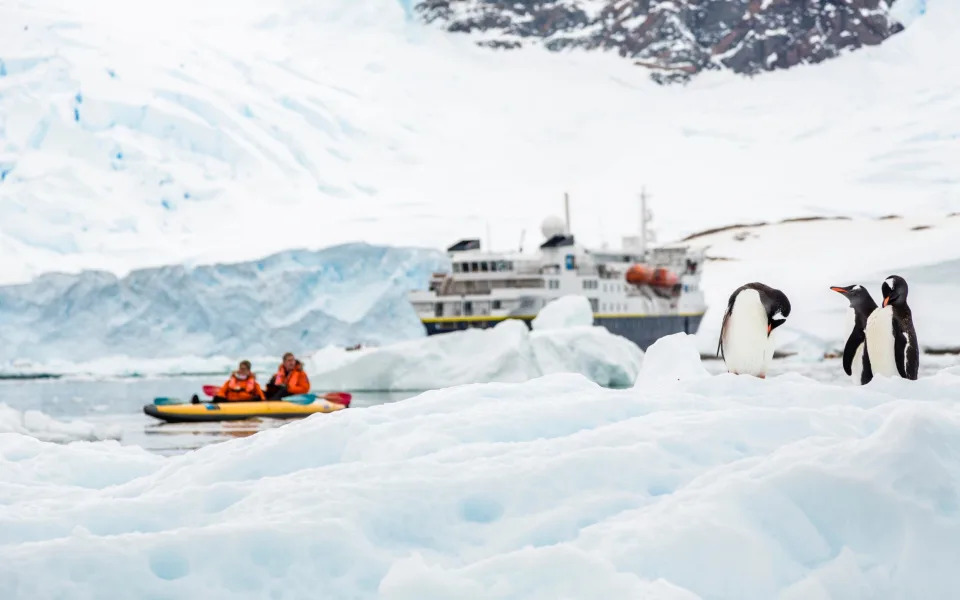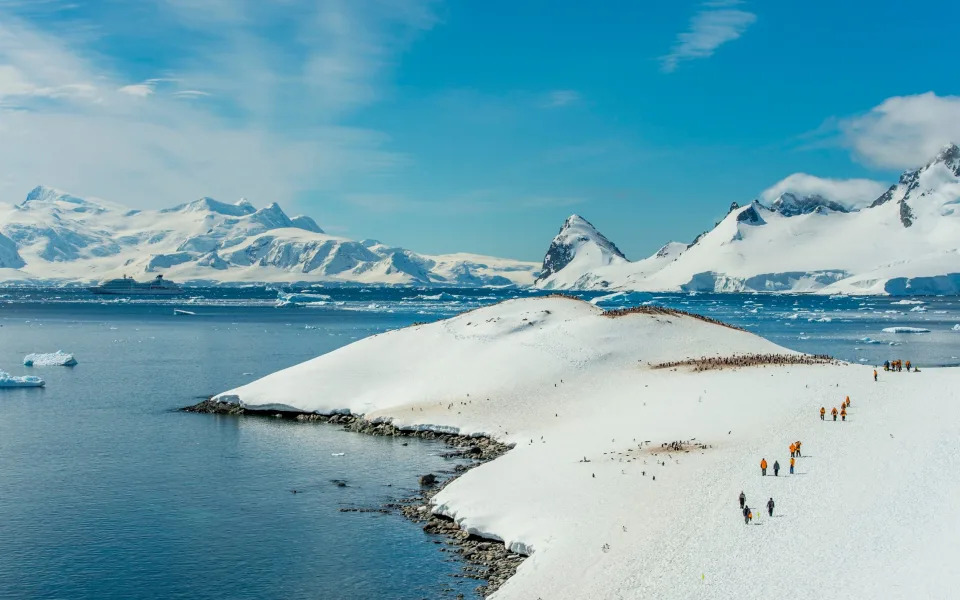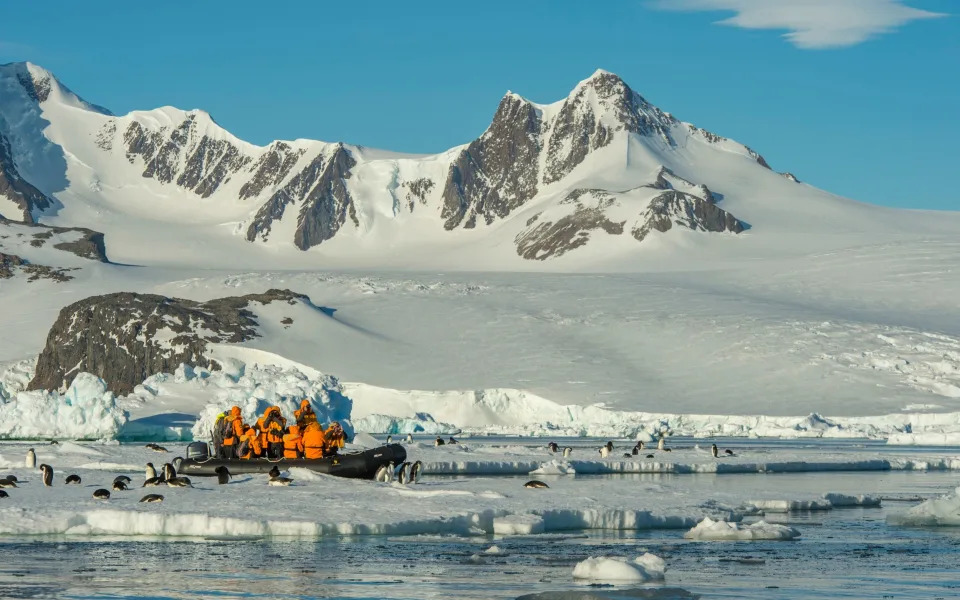Stefanie Waldek
Tue, September 26, 2023

It's not a great year for polar sea ice. Both the Arctic and Antarctic have seen record lows in sea ice extent, according to NASA and the National Snow and Ice Data Center (NSIDC), which use satellite data to track sea ice across both polar regions.
Arctic sea ice likely reached its annual minimum extent this year on Sept. 19 at 1.63 million square miles (4.23 million square kilometers) — the sixth-lowest minimum in the satellite record. And in Antarctica, sea ice likely reached its maximum extent on Sept. 10 at 6.5 million square miles (16.96 million square kilometers) — the lowest maximum ever in the satellite record.
"It’s a record-smashing sea ice low in the Antarctic. Sea ice growth appears low around nearly the whole continent as opposed to any one region," Walt Meier, a sea ice scientist at NSIDC, said in a statement. And in the Arctic, he points out, the Northwest Passage has more open seas than usual.
"There also seems to be a lot more loose, lower concentration ice — even toward the North Pole — and areas that used to be pretty compact, solid sheets of ice through the summer," he said. "That’s been happening more frequently in recent years."
Related: Greenland ice sheets are weaker to climate change than we thought
Each year, sea ice grows and melts with the seasons, and its extent in both directions can be impacted by factors like wind patterns, ocean temperatures — directly correlated with human-induced global warming — and climate patterns like El Niño, which is occurring now.
One of the issues with low sea ice coverage is that it reinforces ocean warming due to the ice-albedo feedback cycle. Sea ice, being white, reflects the sun's energy back out into space, but dark open ocean absorbs it — as such, the waters may remain warmer, inhibiting sea ice growth further.
Related Stories:
— Antarctic currents supplying 40% of world's deep ocean with nutrients and oxygen slowing dramatically
— Satellites reveal catastrophic year for emperor penguins amid climate crisis in Antarctica (photos)
— Ocean current system could shut down as early as 2025, leading to climate disaster
And while sea ice minimum and maximum extents are key measurements in the polar environment, the thickness of that sea ice is another major concern.
"Thickness at the end of the growth season largely determines the survivability of sea ice. New research is using satellites like NASA’s ICESat-2 (Ice, Cloud and land Elevation Satellite-2) to monitor how thick the ice is year-round," said Nathan Kurtz, lab chief of NASA’s Cryospheric Sciences Laboratory at the agency’s Goddard Space Flight Center.
"At NASA we’re interested in taking cutting-edge measurements, but we’re also trying to connect them to the historical record to better understand what’s driving some of these changes that we’re seeing," said Kurtz.
Are Antarctic cruises in jeopardy?
Arctic sea ice likely reached its annual minimum extent this year on Sept. 19 at 1.63 million square miles (4.23 million square kilometers) — the sixth-lowest minimum in the satellite record. And in Antarctica, sea ice likely reached its maximum extent on Sept. 10 at 6.5 million square miles (16.96 million square kilometers) — the lowest maximum ever in the satellite record.
"It’s a record-smashing sea ice low in the Antarctic. Sea ice growth appears low around nearly the whole continent as opposed to any one region," Walt Meier, a sea ice scientist at NSIDC, said in a statement. And in the Arctic, he points out, the Northwest Passage has more open seas than usual.
"There also seems to be a lot more loose, lower concentration ice — even toward the North Pole — and areas that used to be pretty compact, solid sheets of ice through the summer," he said. "That’s been happening more frequently in recent years."
Related: Greenland ice sheets are weaker to climate change than we thought
Each year, sea ice grows and melts with the seasons, and its extent in both directions can be impacted by factors like wind patterns, ocean temperatures — directly correlated with human-induced global warming — and climate patterns like El Niño, which is occurring now.
One of the issues with low sea ice coverage is that it reinforces ocean warming due to the ice-albedo feedback cycle. Sea ice, being white, reflects the sun's energy back out into space, but dark open ocean absorbs it — as such, the waters may remain warmer, inhibiting sea ice growth further.
Related Stories:
— Antarctic currents supplying 40% of world's deep ocean with nutrients and oxygen slowing dramatically
— Satellites reveal catastrophic year for emperor penguins amid climate crisis in Antarctica (photos)
— Ocean current system could shut down as early as 2025, leading to climate disaster
And while sea ice minimum and maximum extents are key measurements in the polar environment, the thickness of that sea ice is another major concern.
"Thickness at the end of the growth season largely determines the survivability of sea ice. New research is using satellites like NASA’s ICESat-2 (Ice, Cloud and land Elevation Satellite-2) to monitor how thick the ice is year-round," said Nathan Kurtz, lab chief of NASA’s Cryospheric Sciences Laboratory at the agency’s Goddard Space Flight Center.
"At NASA we’re interested in taking cutting-edge measurements, but we’re also trying to connect them to the historical record to better understand what’s driving some of these changes that we’re seeing," said Kurtz.
Are Antarctic cruises in jeopardy?
Sara Macefield
THE TELEGRAPH
Sat, September 30, 2023

An increased number of procedures to protect against bird flu have been put in place by expedition cruise companies - Getty
Expedition cruise lines that sail in Antarctica are enforcing stricter precautions against the growing threat of avian flu this winter amid concerns that passengers could be stopped from going ashore to prevent cross-contamination.
Scientists warn that the H5N1 virus will wreak a deadly toll across the continent’s vast penguin colonies if it gains a foothold, and they fear migrating birds from South America – which has already been badly hit by bird flu – will spread the disease as the austral summer approaches.
This also coincides with the main Southern Hemisphere cruise season, which runs from November to March, when more than 60 ships are expected to cross the Drake Passage to visit the Antarctic Peninsula.

There are concerns that cruise passengers could be stopped from going ashore to prevent cross-contamination - Getty
Sailings to the region have boomed in recent years, fuelled by a new generation of modern expedition ships built to withstand extreme conditions, and rising demand from travellers eager to explore this pristine but inhospitable wilderness.
However, the Foreign, Commonwealth and Development Office’s head of polar regions, Dr Jane Rumble, warned in an exclusive interview with the Telegraph that if the worst-case scenario arose, cruise passengers may not be allowed to land.
“They will keep everybody on-board or just do Zodiac cruising,” she said. “Tourists might not necessarily have the holiday they expected.”
Cruise lines and organisations would not be drawn on the implications of this, though the International Association of Antarctica Tour Operators (IAATO), which most expedition cruise companies belong to, tightened up its biosecurity protocols governing members last winter.
Procedures have included assessing landing sites for signs of bird flu, not going ashore if they are present, and leaving if any behavioural signs become apparent. Cruise passengers are told not to sit, kneel or lie down on the ground, or leave any equipment, close to animal activity.

Tourists on Cuverville Island in the Antarctic Peninsula region - Getty
Visitors are also instructed to maintain a minimum distance of five metres between themselves and wildlife wherever possible.
Martin Johnson, chairman and co-founder of UK-based Expedition Cruise Network, which represents many of the leading adventure lines, travelled to Antarctica with member line Ponant last winter and stressed how seriously it was taking biosecurity measures.
“These ranged from thorough cleaning and disinfecting of boots and trouser legs every time we disembarked and embarked the ship to strict adherence of not putting anything on the ground during landings,” he explained.
IAATO confirmed that the additional robust procedures it introduced last season had since evolved and were mandatory for all IAATO companies and their staff operating in Antarctica.
The association’s operations and government affairs director and deputy executive director, Lisa Kelley, said: “IAATO’s protocols will evolve as more information becomes available or if HPAI (highly pathogenic avian influenza) presents.

Tourists exploring Hope Bay in the Antarctic Peninsula region - Getty
“Scientists have shared that HPAI will arrive in Antarctica this year and, in line with our protocols, IAATO operators are prepared to cancel or leave landings where signs of HPAI are identified or suspected.
“Avian influenza is a great concern to the polar community,” she added. “Our members are united in their commitment to operate in the region safely and with environmental responsibility at the heart of all expeditions.”
This winter, IAATO estimates that more than 117,000 people will visit Antarctica on its member lines. Of that total, nearly 40,000 will be on cruise-only expeditions that will not stop in the region.
Under strict rules governing cruise operations in Antarctica, ships carrying more than 500 passengers are not permitted to make landings, so guests can admire the scenery and the experience, but do not leave their ship during sailings.
Smaller vessels carrying 500 passengers or less are allowed to land passengers, but have to abide by strict rules that only permit 100 guests to go ashore at any one time.
Sat, September 30, 2023

An increased number of procedures to protect against bird flu have been put in place by expedition cruise companies - Getty
Expedition cruise lines that sail in Antarctica are enforcing stricter precautions against the growing threat of avian flu this winter amid concerns that passengers could be stopped from going ashore to prevent cross-contamination.
Scientists warn that the H5N1 virus will wreak a deadly toll across the continent’s vast penguin colonies if it gains a foothold, and they fear migrating birds from South America – which has already been badly hit by bird flu – will spread the disease as the austral summer approaches.
This also coincides with the main Southern Hemisphere cruise season, which runs from November to March, when more than 60 ships are expected to cross the Drake Passage to visit the Antarctic Peninsula.

There are concerns that cruise passengers could be stopped from going ashore to prevent cross-contamination - Getty
Sailings to the region have boomed in recent years, fuelled by a new generation of modern expedition ships built to withstand extreme conditions, and rising demand from travellers eager to explore this pristine but inhospitable wilderness.
However, the Foreign, Commonwealth and Development Office’s head of polar regions, Dr Jane Rumble, warned in an exclusive interview with the Telegraph that if the worst-case scenario arose, cruise passengers may not be allowed to land.
“They will keep everybody on-board or just do Zodiac cruising,” she said. “Tourists might not necessarily have the holiday they expected.”
Cruise lines and organisations would not be drawn on the implications of this, though the International Association of Antarctica Tour Operators (IAATO), which most expedition cruise companies belong to, tightened up its biosecurity protocols governing members last winter.
Procedures have included assessing landing sites for signs of bird flu, not going ashore if they are present, and leaving if any behavioural signs become apparent. Cruise passengers are told not to sit, kneel or lie down on the ground, or leave any equipment, close to animal activity.

Tourists on Cuverville Island in the Antarctic Peninsula region - Getty
Visitors are also instructed to maintain a minimum distance of five metres between themselves and wildlife wherever possible.
Martin Johnson, chairman and co-founder of UK-based Expedition Cruise Network, which represents many of the leading adventure lines, travelled to Antarctica with member line Ponant last winter and stressed how seriously it was taking biosecurity measures.
“These ranged from thorough cleaning and disinfecting of boots and trouser legs every time we disembarked and embarked the ship to strict adherence of not putting anything on the ground during landings,” he explained.
IAATO confirmed that the additional robust procedures it introduced last season had since evolved and were mandatory for all IAATO companies and their staff operating in Antarctica.
The association’s operations and government affairs director and deputy executive director, Lisa Kelley, said: “IAATO’s protocols will evolve as more information becomes available or if HPAI (highly pathogenic avian influenza) presents.

Tourists exploring Hope Bay in the Antarctic Peninsula region - Getty
“Scientists have shared that HPAI will arrive in Antarctica this year and, in line with our protocols, IAATO operators are prepared to cancel or leave landings where signs of HPAI are identified or suspected.
“Avian influenza is a great concern to the polar community,” she added. “Our members are united in their commitment to operate in the region safely and with environmental responsibility at the heart of all expeditions.”
This winter, IAATO estimates that more than 117,000 people will visit Antarctica on its member lines. Of that total, nearly 40,000 will be on cruise-only expeditions that will not stop in the region.
Under strict rules governing cruise operations in Antarctica, ships carrying more than 500 passengers are not permitted to make landings, so guests can admire the scenery and the experience, but do not leave their ship during sailings.
Smaller vessels carrying 500 passengers or less are allowed to land passengers, but have to abide by strict rules that only permit 100 guests to go ashore at any one time.
No comments:
Post a Comment